GBU 200: Analyzing Ethical Issues in the Ford Pinto Case Study
VerifiedAdded on 2023/04/19
|7
|1895
|441
Case Study
AI Summary
This case study delves into the Ford Pinto incident, examining the unethical decisions made by Ford Motor Company concerning the safety of their Pinto model. It identifies key stakeholders, including customers, the company, government, shareholders, employees, and the broader community, and analyzes the ethical breaches related to prioritizing cost savings over customer safety. The study highlights the roles of Lee Iacocca and Henry Ford II in the decision-making process that led to the production and sale of a car with a known safety defect. It concludes by assessing the negative impact of these unethical actions on the company's brand and reputation, emphasizing the importance of ethical leadership and decision-making in business. Desklib provides a platform for students to access this and similar case studies for academic support.
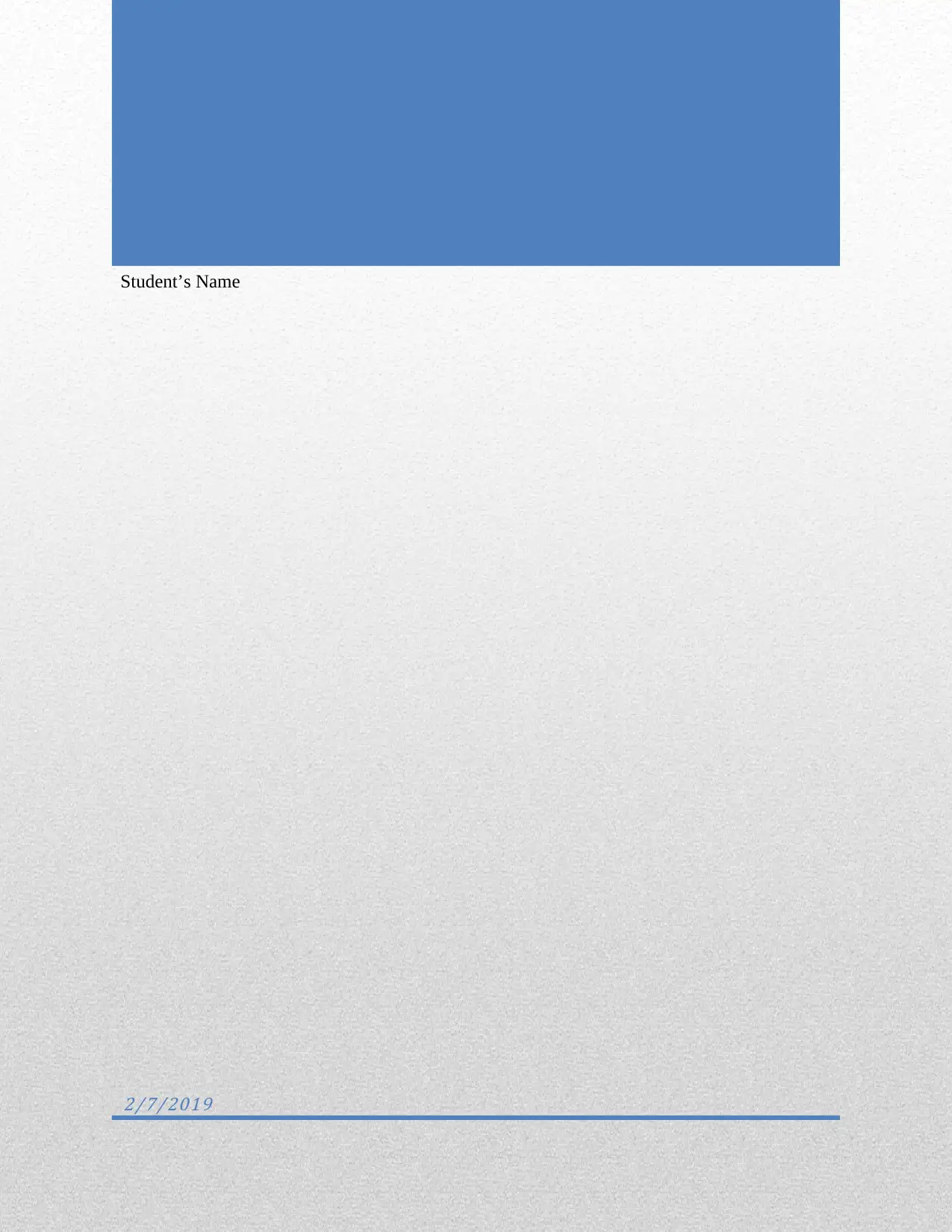
Running Head: BUSINESS AND CORPORATION LAW 0
Business Ethics
Student’s Name
2/7/2019
Business Ethics
Student’s Name
2/7/2019
Paraphrase This Document
Need a fresh take? Get an instant paraphrase of this document with our AI Paraphraser
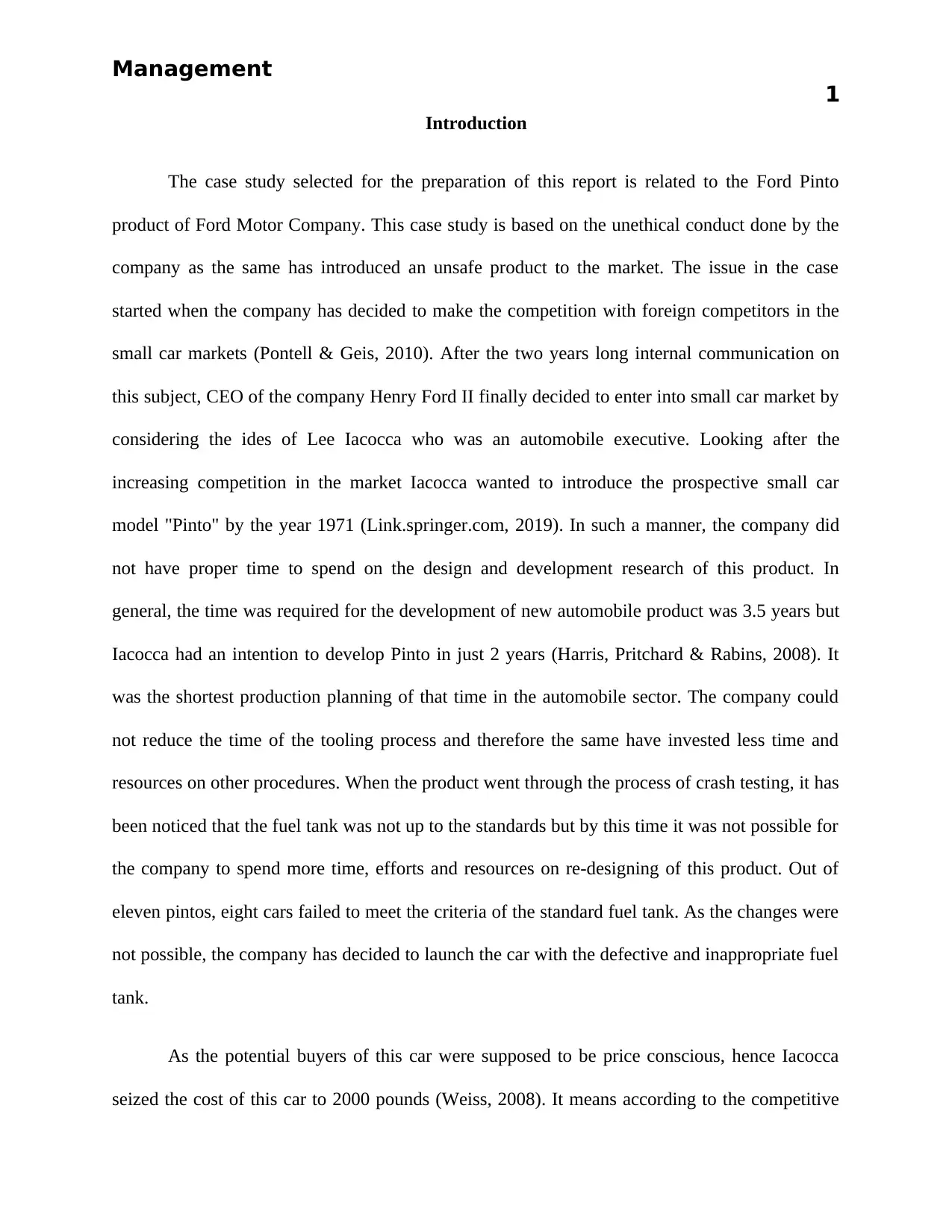
Management
1
Introduction
The case study selected for the preparation of this report is related to the Ford Pinto
product of Ford Motor Company. This case study is based on the unethical conduct done by the
company as the same has introduced an unsafe product to the market. The issue in the case
started when the company has decided to make the competition with foreign competitors in the
small car markets (Pontell & Geis, 2010). After the two years long internal communication on
this subject, CEO of the company Henry Ford II finally decided to enter into small car market by
considering the ides of Lee Iacocca who was an automobile executive. Looking after the
increasing competition in the market Iacocca wanted to introduce the prospective small car
model "Pinto" by the year 1971 (Link.springer.com, 2019). In such a manner, the company did
not have proper time to spend on the design and development research of this product. In
general, the time was required for the development of new automobile product was 3.5 years but
Iacocca had an intention to develop Pinto in just 2 years (Harris, Pritchard & Rabins, 2008). It
was the shortest production planning of that time in the automobile sector. The company could
not reduce the time of the tooling process and therefore the same have invested less time and
resources on other procedures. When the product went through the process of crash testing, it has
been noticed that the fuel tank was not up to the standards but by this time it was not possible for
the company to spend more time, efforts and resources on re-designing of this product. Out of
eleven pintos, eight cars failed to meet the criteria of the standard fuel tank. As the changes were
not possible, the company has decided to launch the car with the defective and inappropriate fuel
tank.
As the potential buyers of this car were supposed to be price conscious, hence Iacocca
seized the cost of this car to 2000 pounds (Weiss, 2008). It means according to the competitive
1
Introduction
The case study selected for the preparation of this report is related to the Ford Pinto
product of Ford Motor Company. This case study is based on the unethical conduct done by the
company as the same has introduced an unsafe product to the market. The issue in the case
started when the company has decided to make the competition with foreign competitors in the
small car markets (Pontell & Geis, 2010). After the two years long internal communication on
this subject, CEO of the company Henry Ford II finally decided to enter into small car market by
considering the ides of Lee Iacocca who was an automobile executive. Looking after the
increasing competition in the market Iacocca wanted to introduce the prospective small car
model "Pinto" by the year 1971 (Link.springer.com, 2019). In such a manner, the company did
not have proper time to spend on the design and development research of this product. In
general, the time was required for the development of new automobile product was 3.5 years but
Iacocca had an intention to develop Pinto in just 2 years (Harris, Pritchard & Rabins, 2008). It
was the shortest production planning of that time in the automobile sector. The company could
not reduce the time of the tooling process and therefore the same have invested less time and
resources on other procedures. When the product went through the process of crash testing, it has
been noticed that the fuel tank was not up to the standards but by this time it was not possible for
the company to spend more time, efforts and resources on re-designing of this product. Out of
eleven pintos, eight cars failed to meet the criteria of the standard fuel tank. As the changes were
not possible, the company has decided to launch the car with the defective and inappropriate fuel
tank.
As the potential buyers of this car were supposed to be price conscious, hence Iacocca
seized the cost of this car to 2000 pounds (Weiss, 2008). It means according to the competitive
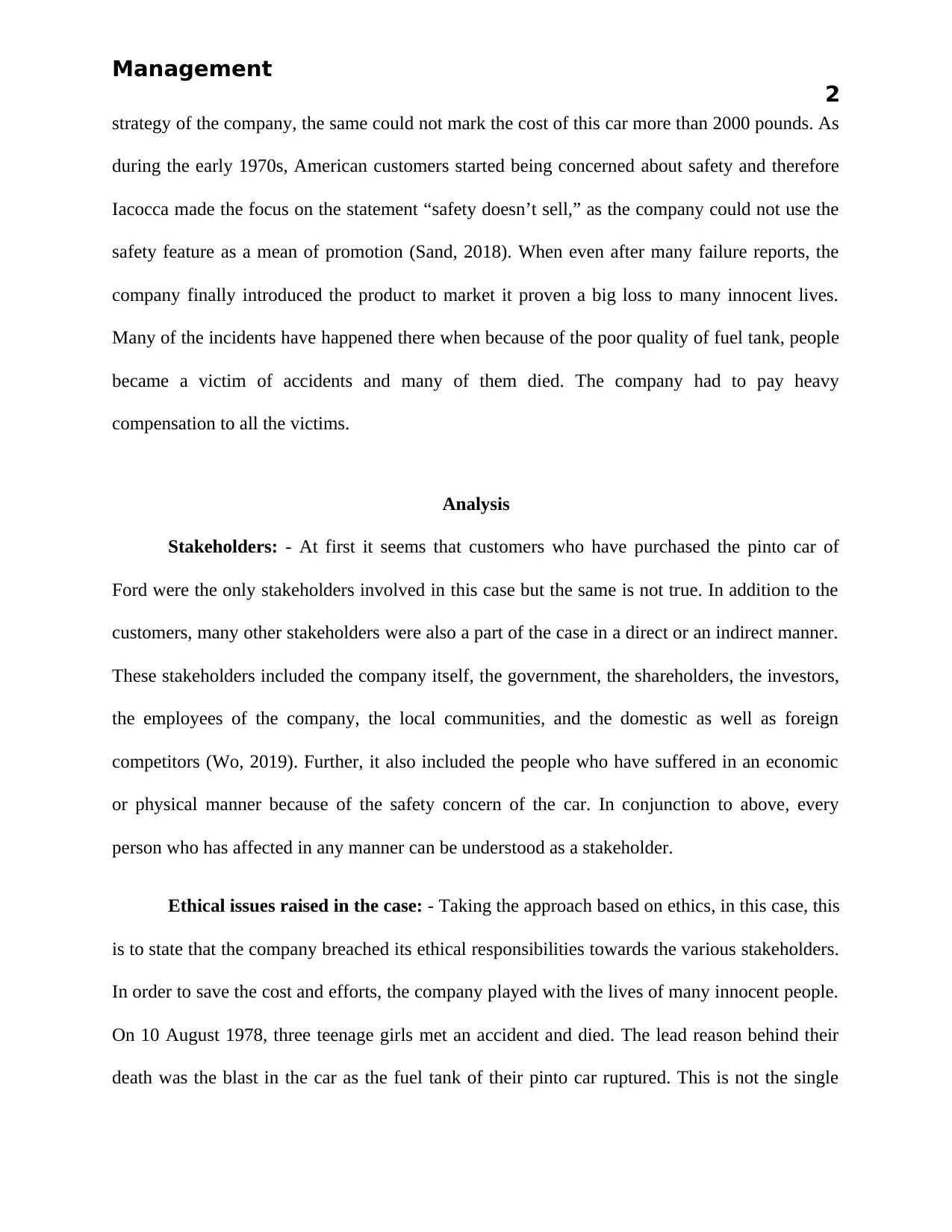
Management
2
strategy of the company, the same could not mark the cost of this car more than 2000 pounds. As
during the early 1970s, American customers started being concerned about safety and therefore
Iacocca made the focus on the statement “safety doesn’t sell,” as the company could not use the
safety feature as a mean of promotion (Sand, 2018). When even after many failure reports, the
company finally introduced the product to market it proven a big loss to many innocent lives.
Many of the incidents have happened there when because of the poor quality of fuel tank, people
became a victim of accidents and many of them died. The company had to pay heavy
compensation to all the victims.
Analysis
Stakeholders: - At first it seems that customers who have purchased the pinto car of
Ford were the only stakeholders involved in this case but the same is not true. In addition to the
customers, many other stakeholders were also a part of the case in a direct or an indirect manner.
These stakeholders included the company itself, the government, the shareholders, the investors,
the employees of the company, the local communities, and the domestic as well as foreign
competitors (Wo, 2019). Further, it also included the people who have suffered in an economic
or physical manner because of the safety concern of the car. In conjunction to above, every
person who has affected in any manner can be understood as a stakeholder.
Ethical issues raised in the case: - Taking the approach based on ethics, in this case, this
is to state that the company breached its ethical responsibilities towards the various stakeholders.
In order to save the cost and efforts, the company played with the lives of many innocent people.
On 10 August 1978, three teenage girls met an accident and died. The lead reason behind their
death was the blast in the car as the fuel tank of their pinto car ruptured. This is not the single
2
strategy of the company, the same could not mark the cost of this car more than 2000 pounds. As
during the early 1970s, American customers started being concerned about safety and therefore
Iacocca made the focus on the statement “safety doesn’t sell,” as the company could not use the
safety feature as a mean of promotion (Sand, 2018). When even after many failure reports, the
company finally introduced the product to market it proven a big loss to many innocent lives.
Many of the incidents have happened there when because of the poor quality of fuel tank, people
became a victim of accidents and many of them died. The company had to pay heavy
compensation to all the victims.
Analysis
Stakeholders: - At first it seems that customers who have purchased the pinto car of
Ford were the only stakeholders involved in this case but the same is not true. In addition to the
customers, many other stakeholders were also a part of the case in a direct or an indirect manner.
These stakeholders included the company itself, the government, the shareholders, the investors,
the employees of the company, the local communities, and the domestic as well as foreign
competitors (Wo, 2019). Further, it also included the people who have suffered in an economic
or physical manner because of the safety concern of the car. In conjunction to above, every
person who has affected in any manner can be understood as a stakeholder.
Ethical issues raised in the case: - Taking the approach based on ethics, in this case, this
is to state that the company breached its ethical responsibilities towards the various stakeholders.
In order to save the cost and efforts, the company played with the lives of many innocent people.
On 10 August 1978, three teenage girls met an accident and died. The lead reason behind their
death was the blast in the car as the fuel tank of their pinto car ruptured. This is not the single
⊘ This is a preview!⊘
Do you want full access?
Subscribe today to unlock all pages.

Trusted by 1+ million students worldwide
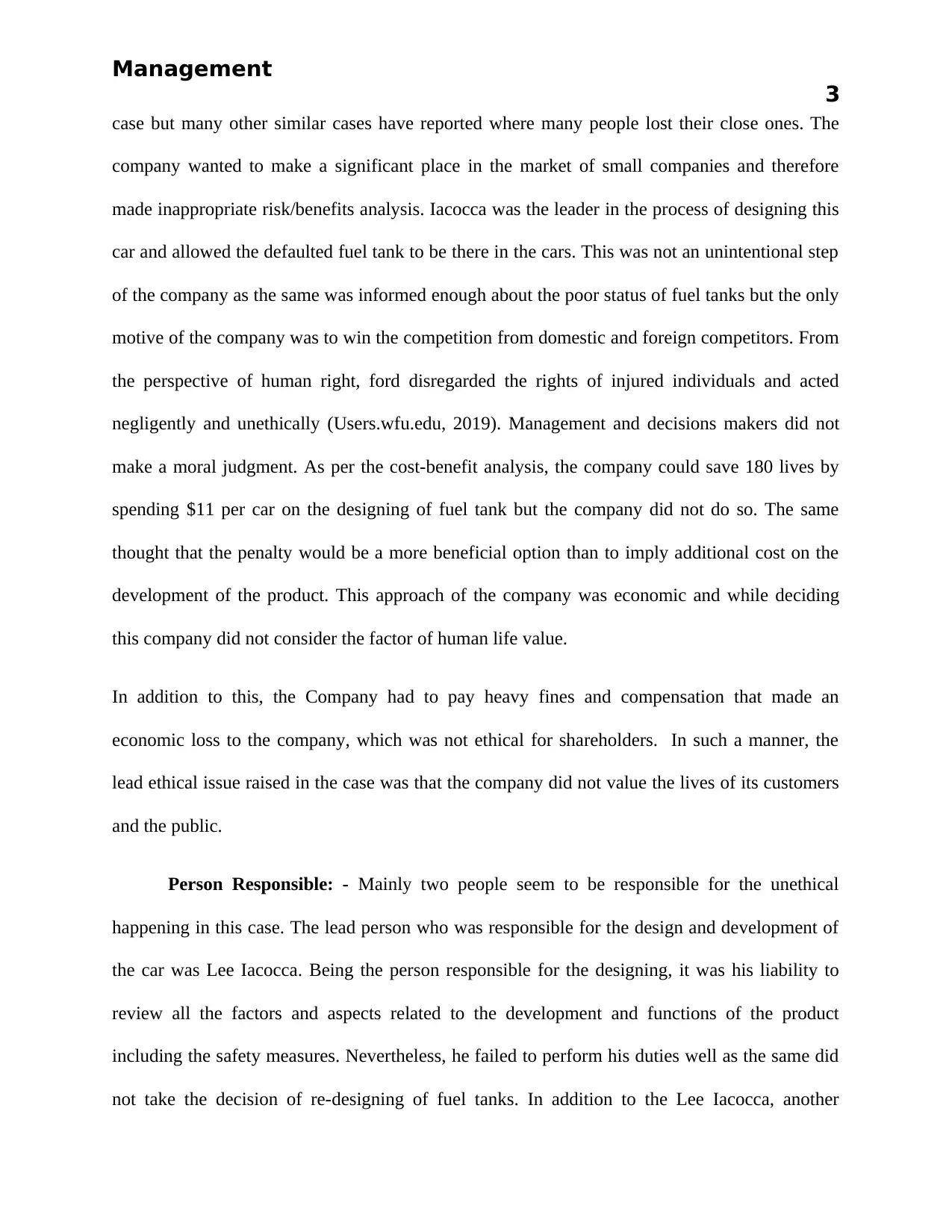
Management
3
case but many other similar cases have reported where many people lost their close ones. The
company wanted to make a significant place in the market of small companies and therefore
made inappropriate risk/benefits analysis. Iacocca was the leader in the process of designing this
car and allowed the defaulted fuel tank to be there in the cars. This was not an unintentional step
of the company as the same was informed enough about the poor status of fuel tanks but the only
motive of the company was to win the competition from domestic and foreign competitors. From
the perspective of human right, ford disregarded the rights of injured individuals and acted
negligently and unethically (Users.wfu.edu, 2019). Management and decisions makers did not
make a moral judgment. As per the cost-benefit analysis, the company could save 180 lives by
spending $11 per car on the designing of fuel tank but the company did not do so. The same
thought that the penalty would be a more beneficial option than to imply additional cost on the
development of the product. This approach of the company was economic and while deciding
this company did not consider the factor of human life value.
In addition to this, the Company had to pay heavy fines and compensation that made an
economic loss to the company, which was not ethical for shareholders. In such a manner, the
lead ethical issue raised in the case was that the company did not value the lives of its customers
and the public.
Person Responsible: - Mainly two people seem to be responsible for the unethical
happening in this case. The lead person who was responsible for the design and development of
the car was Lee Iacocca. Being the person responsible for the designing, it was his liability to
review all the factors and aspects related to the development and functions of the product
including the safety measures. Nevertheless, he failed to perform his duties well as the same did
not take the decision of re-designing of fuel tanks. In addition to the Lee Iacocca, another
3
case but many other similar cases have reported where many people lost their close ones. The
company wanted to make a significant place in the market of small companies and therefore
made inappropriate risk/benefits analysis. Iacocca was the leader in the process of designing this
car and allowed the defaulted fuel tank to be there in the cars. This was not an unintentional step
of the company as the same was informed enough about the poor status of fuel tanks but the only
motive of the company was to win the competition from domestic and foreign competitors. From
the perspective of human right, ford disregarded the rights of injured individuals and acted
negligently and unethically (Users.wfu.edu, 2019). Management and decisions makers did not
make a moral judgment. As per the cost-benefit analysis, the company could save 180 lives by
spending $11 per car on the designing of fuel tank but the company did not do so. The same
thought that the penalty would be a more beneficial option than to imply additional cost on the
development of the product. This approach of the company was economic and while deciding
this company did not consider the factor of human life value.
In addition to this, the Company had to pay heavy fines and compensation that made an
economic loss to the company, which was not ethical for shareholders. In such a manner, the
lead ethical issue raised in the case was that the company did not value the lives of its customers
and the public.
Person Responsible: - Mainly two people seem to be responsible for the unethical
happening in this case. The lead person who was responsible for the design and development of
the car was Lee Iacocca. Being the person responsible for the designing, it was his liability to
review all the factors and aspects related to the development and functions of the product
including the safety measures. Nevertheless, he failed to perform his duties well as the same did
not take the decision of re-designing of fuel tanks. In addition to the Lee Iacocca, another
Paraphrase This Document
Need a fresh take? Get an instant paraphrase of this document with our AI Paraphraser
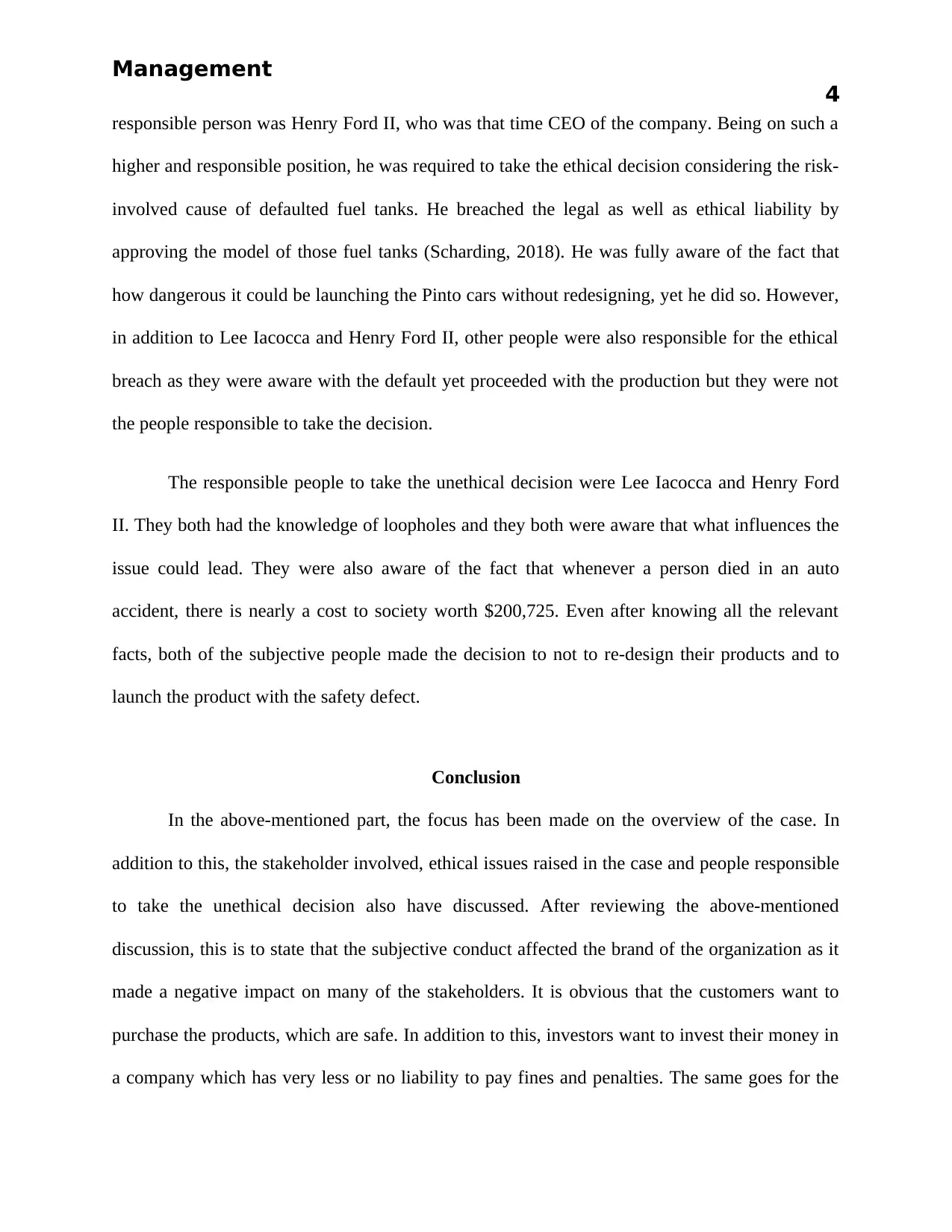
Management
4
responsible person was Henry Ford II, who was that time CEO of the company. Being on such a
higher and responsible position, he was required to take the ethical decision considering the risk-
involved cause of defaulted fuel tanks. He breached the legal as well as ethical liability by
approving the model of those fuel tanks (Scharding, 2018). He was fully aware of the fact that
how dangerous it could be launching the Pinto cars without redesigning, yet he did so. However,
in addition to Lee Iacocca and Henry Ford II, other people were also responsible for the ethical
breach as they were aware with the default yet proceeded with the production but they were not
the people responsible to take the decision.
The responsible people to take the unethical decision were Lee Iacocca and Henry Ford
II. They both had the knowledge of loopholes and they both were aware that what influences the
issue could lead. They were also aware of the fact that whenever a person died in an auto
accident, there is nearly a cost to society worth $200,725. Even after knowing all the relevant
facts, both of the subjective people made the decision to not to re-design their products and to
launch the product with the safety defect.
Conclusion
In the above-mentioned part, the focus has been made on the overview of the case. In
addition to this, the stakeholder involved, ethical issues raised in the case and people responsible
to take the unethical decision also have discussed. After reviewing the above-mentioned
discussion, this is to state that the subjective conduct affected the brand of the organization as it
made a negative impact on many of the stakeholders. It is obvious that the customers want to
purchase the products, which are safe. In addition to this, investors want to invest their money in
a company which has very less or no liability to pay fines and penalties. The same goes for the
4
responsible person was Henry Ford II, who was that time CEO of the company. Being on such a
higher and responsible position, he was required to take the ethical decision considering the risk-
involved cause of defaulted fuel tanks. He breached the legal as well as ethical liability by
approving the model of those fuel tanks (Scharding, 2018). He was fully aware of the fact that
how dangerous it could be launching the Pinto cars without redesigning, yet he did so. However,
in addition to Lee Iacocca and Henry Ford II, other people were also responsible for the ethical
breach as they were aware with the default yet proceeded with the production but they were not
the people responsible to take the decision.
The responsible people to take the unethical decision were Lee Iacocca and Henry Ford
II. They both had the knowledge of loopholes and they both were aware that what influences the
issue could lead. They were also aware of the fact that whenever a person died in an auto
accident, there is nearly a cost to society worth $200,725. Even after knowing all the relevant
facts, both of the subjective people made the decision to not to re-design their products and to
launch the product with the safety defect.
Conclusion
In the above-mentioned part, the focus has been made on the overview of the case. In
addition to this, the stakeholder involved, ethical issues raised in the case and people responsible
to take the unethical decision also have discussed. After reviewing the above-mentioned
discussion, this is to state that the subjective conduct affected the brand of the organization as it
made a negative impact on many of the stakeholders. It is obvious that the customers want to
purchase the products, which are safe. In addition to this, investors want to invest their money in
a company which has very less or no liability to pay fines and penalties. The same goes for the
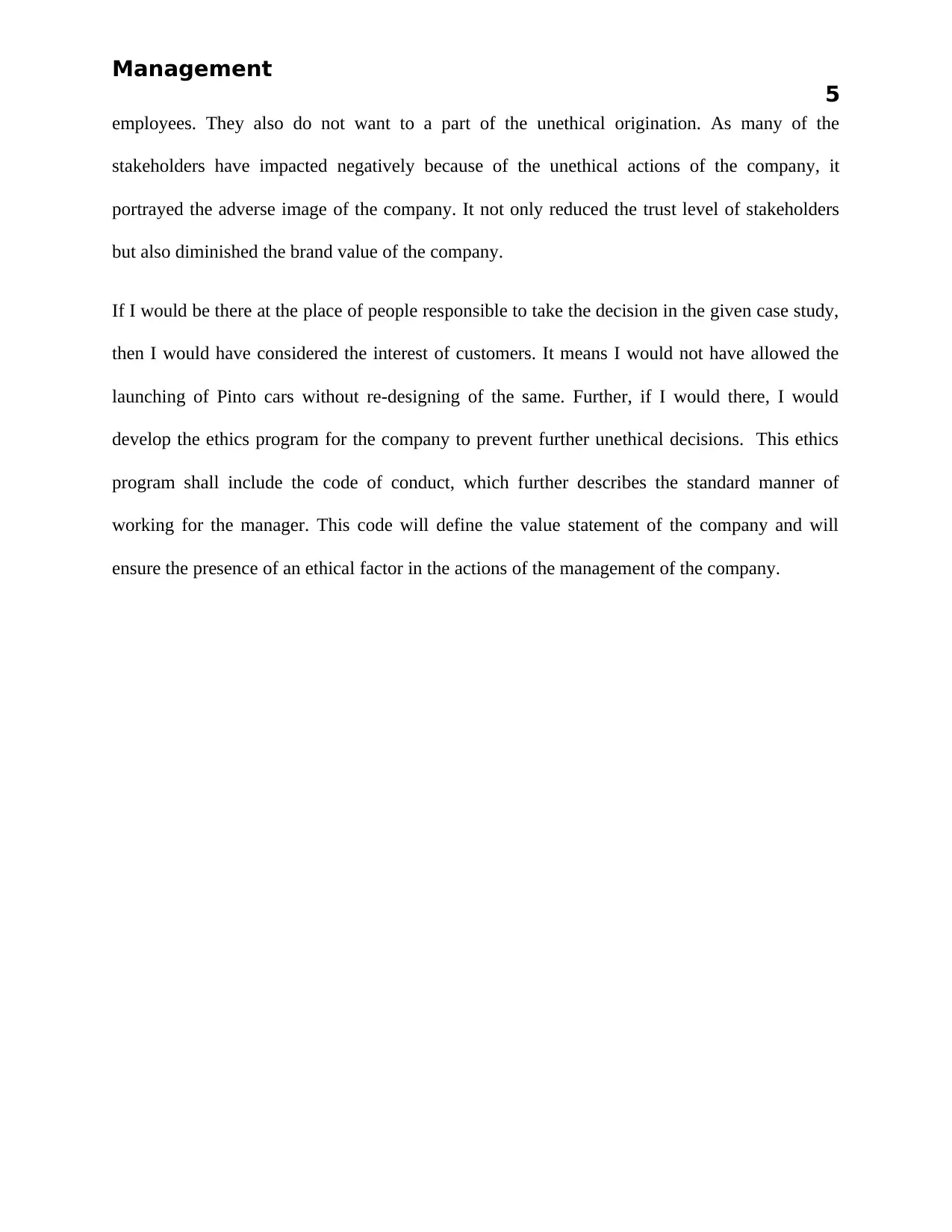
Management
5
employees. They also do not want to a part of the unethical origination. As many of the
stakeholders have impacted negatively because of the unethical actions of the company, it
portrayed the adverse image of the company. It not only reduced the trust level of stakeholders
but also diminished the brand value of the company.
If I would be there at the place of people responsible to take the decision in the given case study,
then I would have considered the interest of customers. It means I would not have allowed the
launching of Pinto cars without re-designing of the same. Further, if I would there, I would
develop the ethics program for the company to prevent further unethical decisions. This ethics
program shall include the code of conduct, which further describes the standard manner of
working for the manager. This code will define the value statement of the company and will
ensure the presence of an ethical factor in the actions of the management of the company.
5
employees. They also do not want to a part of the unethical origination. As many of the
stakeholders have impacted negatively because of the unethical actions of the company, it
portrayed the adverse image of the company. It not only reduced the trust level of stakeholders
but also diminished the brand value of the company.
If I would be there at the place of people responsible to take the decision in the given case study,
then I would have considered the interest of customers. It means I would not have allowed the
launching of Pinto cars without re-designing of the same. Further, if I would there, I would
develop the ethics program for the company to prevent further unethical decisions. This ethics
program shall include the code of conduct, which further describes the standard manner of
working for the manager. This code will define the value statement of the company and will
ensure the presence of an ethical factor in the actions of the management of the company.
⊘ This is a preview!⊘
Do you want full access?
Subscribe today to unlock all pages.

Trusted by 1+ million students worldwide
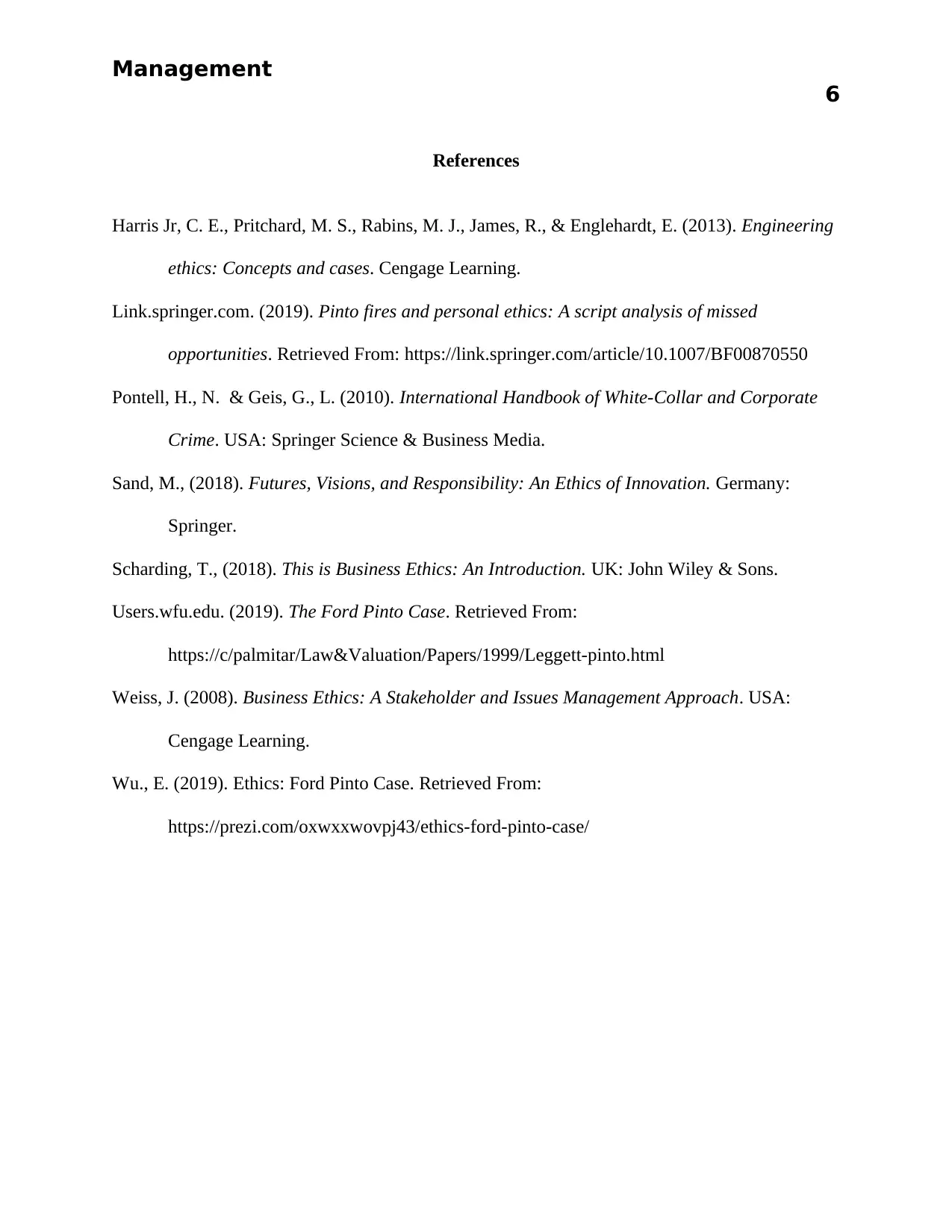
Management
6
References
Harris Jr, C. E., Pritchard, M. S., Rabins, M. J., James, R., & Englehardt, E. (2013). Engineering
ethics: Concepts and cases. Cengage Learning.
Link.springer.com. (2019). Pinto fires and personal ethics: A script analysis of missed
opportunities. Retrieved From: https://link.springer.com/article/10.1007/BF00870550
Pontell, H., N. & Geis, G., L. (2010). International Handbook of White-Collar and Corporate
Crime. USA: Springer Science & Business Media.
Sand, M., (2018). Futures, Visions, and Responsibility: An Ethics of Innovation. Germany:
Springer.
Scharding, T., (2018). This is Business Ethics: An Introduction. UK: John Wiley & Sons.
Users.wfu.edu. (2019). The Ford Pinto Case. Retrieved From:
https://c/palmitar/Law&Valuation/Papers/1999/Leggett-pinto.html
Weiss, J. (2008). Business Ethics: A Stakeholder and Issues Management Approach. USA:
Cengage Learning.
Wu., E. (2019). Ethics: Ford Pinto Case. Retrieved From:
https://prezi.com/oxwxxwovpj43/ethics-ford-pinto-case/
6
References
Harris Jr, C. E., Pritchard, M. S., Rabins, M. J., James, R., & Englehardt, E. (2013). Engineering
ethics: Concepts and cases. Cengage Learning.
Link.springer.com. (2019). Pinto fires and personal ethics: A script analysis of missed
opportunities. Retrieved From: https://link.springer.com/article/10.1007/BF00870550
Pontell, H., N. & Geis, G., L. (2010). International Handbook of White-Collar and Corporate
Crime. USA: Springer Science & Business Media.
Sand, M., (2018). Futures, Visions, and Responsibility: An Ethics of Innovation. Germany:
Springer.
Scharding, T., (2018). This is Business Ethics: An Introduction. UK: John Wiley & Sons.
Users.wfu.edu. (2019). The Ford Pinto Case. Retrieved From:
https://c/palmitar/Law&Valuation/Papers/1999/Leggett-pinto.html
Weiss, J. (2008). Business Ethics: A Stakeholder and Issues Management Approach. USA:
Cengage Learning.
Wu., E. (2019). Ethics: Ford Pinto Case. Retrieved From:
https://prezi.com/oxwxxwovpj43/ethics-ford-pinto-case/
1 out of 7
Related Documents
Your All-in-One AI-Powered Toolkit for Academic Success.
+13062052269
info@desklib.com
Available 24*7 on WhatsApp / Email
![[object Object]](/_next/static/media/star-bottom.7253800d.svg)
Unlock your academic potential
Copyright © 2020–2025 A2Z Services. All Rights Reserved. Developed and managed by ZUCOL.




